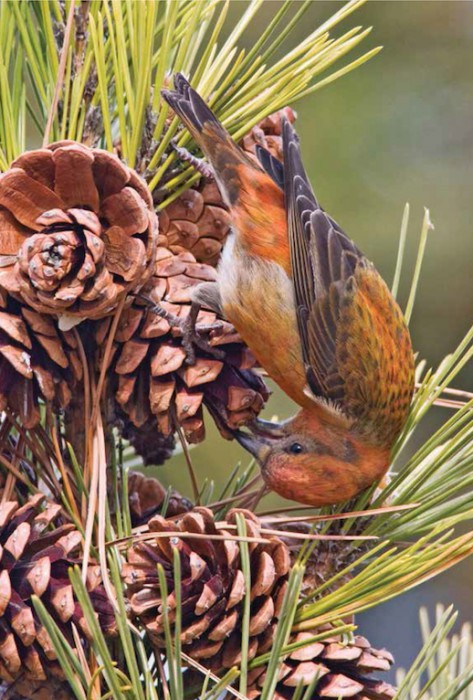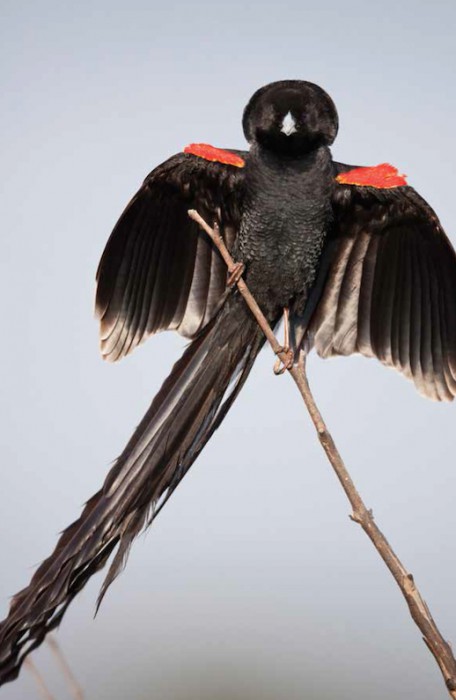Tales of Remarkable Birds by Dominic Couzens
Bloomsbury, 224 pages, 120 colour photographs
Review by David Callahan
Anyone whoever watched the BBC’s The Life of Birds knows that there is a plethora of quirky, cryptic, brutal and astonishing bird behaviours in the world, and with more than 10,000 living species the series could be said to have only dabbled in the most dramatic and televisual.
There several times as many more displays, habits and rituals than there are species, and Dominic Couzens does a good job in Tales of Remarkable Birds of relating some of the less cliched but still engaging of these, keeping your interest piqued with a wide reading of fairly up-to-the-minute research. Even well-known classics such as the communal leks of Andean Cock-of-the-Rock are given added detail and understanding.
Taking around five species from each continent in turn (plus a few extra island forms), we are taken on a tour through not just behaviour but, in a winding way, through the tricks of evolution itself. Along the route we meet sneaky and murderous Great Spotted Cuckoos, Great Bowerbirds playing fast and loose with perspective as they arrange their monochrome, pebble-dashed show homes, and the amazing feats of memory performed by Black-capped Chickadees.
This is a real trove of ‘did you knows’, and Couzens produces some deep insights from the ever-accumulating research of ornithologists into the motivations of the learned and instinctive actions of birds. Many are familiar with the communal roosts of Wrens in winter in this country, but how many of us have considered how they have to overcome an intense and violent territoriality to huddle up sometimes 60 to a disused nest box? In Australia, White-winged Choughs kidnap youngsters from rival flocks to drive up their own group’s numbers, to be able to provide for even more young. In Africa, Malachite Sunbird has learnt to hover while feeding on introduced tobacco flowers, echoing the pre-evolved behaviour of the hummingbirds that pollinate the tobacco plant in its native South America.
In the Neotropics themselves, toucans bills have become Swiss Army knives, used for reaching for food, with serrated edges to grip fruit, strength to to do battle with rivals, bright patterns which serve to intimidate other competing species, and a hooked end to rip apart the nests of oropendolas and caciques, and destroy their eggs and chicks. In the Antarctic Ocean, albatrosses wander up to 184,000 km per year and dive to 12 metres when chasing squid. In Asia, Greater Racket-tailed Drongos startle other species into dropping morsels of food, while in the Middle East, Arabian Babblers lose social status by accepting the superficially altruistic preening and feeding of other flock-mates.
Heading to the unique species found on isolated islands brings a treasury of idiosyncrasy, with the mound-building megapodes and young which really do hatch and hit the ground running, and the scarily intelligent New Caledonian Crow, which makes, customises and uses tools, and may well be reading this review by the time it is published.
A final chapter on the numerous extinctions of the Hawaiian honeycreepers drives home the loss of behaviours we will never see or understand, and the devastating influence of human behaviour on the fragility of creatures that are otherwise dynamically resilient and tenacious.
The author admits early on that he has chosen the dramatic and grotesque, and the bright and beautiful, over the more mundane and streaky brown. By its nature cherry-picked, the book still gives a grand sweeping overview of the endless variety of ways in which birds attract and repel each other, how they construct homes and migrate to different continents, how they care for and betray each other, and how they feed and flock. This is not only a good present for those with a nascent interest in the avian world, but a very enjoyable browse for people already a long way along the ornithological path.
The Wolfhounds (David’s band) latest CD is available now. They play live at the Lexington, London, with the Membranes on 22 May and at The Victoria, Dalston, London, with Prolapse on 30 May.

